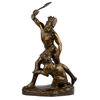
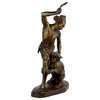
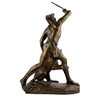
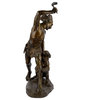
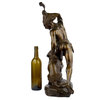
Item 1 of 5







Item 1 of 5


- Product Description
- Product Specifications
- Shipping and Returns
An intense and dramatic scene capturing a moment of danger in the frontier, it would seem this Native American warrior was attempting to snare and kill this lynx, though the hunt has gone wrong and the beast is equally ready for the fight. The balance of the two is perhaps the more interesting story of the group, where the ending cannot be determined from the material presented. We can hope the warrior defeated his foe, but the claws on his leg are powerful and determined as the cat rears his head in fury. The bronze is cast in the lost-wax method with an acid patina creating a beautiful blend of golds, burnished brass and darker brown accents in both figures. They stand over a naturalistic base signed in his typical block lettering CARTIER. It is a rare and powerful group, one of many various models he sculpted capturing Native American warriors battling nature's foes, including several other wonderfully varied models of warriors fighting large cats including tigers, panthers and wild cats.
Born in Marseilles in February of 1879, Thomas Francois Cartier was an animalier best known for his small bronze sculptures of dogs - specifically bull terriers and retrievers. He studied under Georges Gardet, an animal sculptor and inherited his passion for unfaltering realism and detail, though his work tended more towards Romantic idealism in figuring his scenes and animal emotions than his Animalier contemporaries. In the beginning of the 20th century, Cartier began exhibiting regularly at Salon des Artistes Français, being distinguished with hors-concours (honorable mention) in 1908 and achieving a gold medal in 1927. He also exhibited at the Salon d’Automne. Cartier's passion for naturalism in his work tended towards the savage, his work often honing in on animals with an innate aggressive nature: lions, hunting dogs, wolves, fighting deer and birds of prey. More infrequently, though nonetheless successfully, Thomas Francois Cartier dabbled in frontier-inspired themes with a few of his bronzes depicting warriors riding horseback or Native Americans fighting wild animals.
Born in Marseilles in February of 1879, Thomas Francois Cartier was an animalier best known for his small bronze sculptures of dogs - specifically bull terriers and retrievers. He studied under Georges Gardet, an animal sculptor and inherited his passion for unfaltering realism and detail, though his work tended more towards Romantic idealism in figuring his scenes and animal emotions than his Animalier contemporaries. In the beginning of the 20th century, Cartier began exhibiting regularly at Salon des Artistes Français, being distinguished with hors-concours (honorable mention) in 1908 and achieving a gold medal in 1927. He also exhibited at the Salon d’Automne. Cartier's passion for naturalism in his work tended towards the savage, his work often honing in on animals with an innate aggressive nature: lions, hunting dogs, wolves, fighting deer and birds of prey. More infrequently, though nonetheless successfully, Thomas Francois Cartier dabbled in frontier-inspired themes with a few of his bronzes depicting warriors riding horseback or Native Americans fighting wild animals.
Literature & Further Reading:
- Bronzes of the Nineteenth Century: Dictionary of Artists, Pierre Kjellberg
- E. Benezit Dictionary of Artists, vol. III, Gründ, 2006
- Animals in Bronze, Christopher Payne
- Dictionnaire de Sculpteurs de l’ecole Française, Stanislas Lami
- Art Bronzes, Michael Forrest
- The Animaliers, James Mackay
- Les Animaliers, Jane Horswell
Condition Report:
Some bending to the handle of the axe. Originality of the harness around wildcat’s neck is unknown. Original patina with discoloration and light handling wear/minor scuffs. Cleaned, polished and in beautiful presentation-ready condition.Consigned French Bronze Sculpture of Indian Warrior by Thomas Cartier
An intense and dramatic scene capturing a moment of danger in the frontier, it would seem this Native American warrior was attempting to snare and kill this lynx, though the hunt has gone wrong and the beast is equally ready for the fight. The balance of the two is perhaps the more interesting story of the group, where the ending cannot be determined from the material presented. We can hope the warrior defeated his foe, but the claws on his leg are powerful and determined as the cat rears his head in fury. The bronze is cast in the lost-wax method with an acid patina creating a beautiful blend of golds, burnished brass and darker brown accents in both figures. They stand over a naturalistic base signed in his typical block lettering CARTIER. It is a rare and powerful group, one of many various models he sculpted capturing Native American warriors battling nature's foes, including several other wonderfully varied models of warriors fighting large cats including tigers, panthers and wild cats.
Born in Marseilles in February of 1879, Thomas Francois Cartier was an animalier best known for his small bronze sculptures of dogs - specifically bull terriers and retrievers. He studied under Georges Gardet, an animal sculptor and inherited his passion for unfaltering realism and detail, though his work tended more towards Romantic idealism in figuring his scenes and animal emotions than his Animalier contemporaries. In the beginning of the 20th century, Cartier began exhibiting regularly at Salon des Artistes Français, being distinguished with hors-concours (honorable mention) in 1908 and achieving a gold medal in 1927. He also exhibited at the Salon d’Automne. Cartier's passion for naturalism in his work tended towards the savage, his work often honing in on animals with an innate aggressive nature: lions, hunting dogs, wolves, fighting deer and birds of prey. More infrequently, though nonetheless successfully, Thomas Francois Cartier dabbled in frontier-inspired themes with a few of his bronzes depicting warriors riding horseback or Native Americans fighting wild animals.
Born in Marseilles in February of 1879, Thomas Francois Cartier was an animalier best known for his small bronze sculptures of dogs - specifically bull terriers and retrievers. He studied under Georges Gardet, an animal sculptor and inherited his passion for unfaltering realism and detail, though his work tended more towards Romantic idealism in figuring his scenes and animal emotions than his Animalier contemporaries. In the beginning of the 20th century, Cartier began exhibiting regularly at Salon des Artistes Français, being distinguished with hors-concours (honorable mention) in 1908 and achieving a gold medal in 1927. He also exhibited at the Salon d’Automne. Cartier's passion for naturalism in his work tended towards the savage, his work often honing in on animals with an innate aggressive nature: lions, hunting dogs, wolves, fighting deer and birds of prey. More infrequently, though nonetheless successfully, Thomas Francois Cartier dabbled in frontier-inspired themes with a few of his bronzes depicting warriors riding horseback or Native Americans fighting wild animals.
Literature & Further Reading:
- Bronzes of the Nineteenth Century: Dictionary of Artists, Pierre Kjellberg
- E. Benezit Dictionary of Artists, vol. III, Gründ, 2006
- Animals in Bronze, Christopher Payne
- Dictionnaire de Sculpteurs de l’ecole Française, Stanislas Lami
- Art Bronzes, Michael Forrest
- The Animaliers, James Mackay
- Les Animaliers, Jane Horswell
Condition Report:
Some bending to the handle of the axe. Originality of the harness around wildcat’s neck is unknown. Original patina with discoloration and light handling wear/minor scuffs. Cleaned, polished and in beautiful presentation-ready condition.- Product ID
- 134870115
- Size/Weight
- W 15.5" / D 8" / H 23.75" / 25 lb.
- Materials
- Bronze
- Assembly Required
- No
- Category
- Sculptures
- Style
- Victorian
- Product Description
- Product Specifications
- Shipping and Returns
An intense and dramatic scene capturing a moment of danger in the frontier, it would seem this Native American warrior was attempting to snare and kill this lynx, though the hunt has gone wrong and the beast is equally ready for the fight. The balance of the two is perhaps the more interesting story of the group, where the ending cannot be determined from the material presented. We can hope the warrior defeated his foe, but the claws on his leg are powerful and determined as the cat rears his head in fury. The bronze is cast in the lost-wax method with an acid patina creating a beautiful blend of golds, burnished brass and darker brown accents in both figures. They stand over a naturalistic base signed in his typical block lettering CARTIER. It is a rare and powerful group, one of many various models he sculpted capturing Native American warriors battling nature's foes, including several other wonderfully varied models of warriors fighting large cats including tigers, panthers and wild cats.
Born in Marseilles in February of 1879, Thomas Francois Cartier was an animalier best known for his small bronze sculptures of dogs - specifically bull terriers and retrievers. He studied under Georges Gardet, an animal sculptor and inherited his passion for unfaltering realism and detail, though his work tended more towards Romantic idealism in figuring his scenes and animal emotions than his Animalier contemporaries. In the beginning of the 20th century, Cartier began exhibiting regularly at Salon des Artistes Français, being distinguished with hors-concours (honorable mention) in 1908 and achieving a gold medal in 1927. He also exhibited at the Salon d’Automne. Cartier's passion for naturalism in his work tended towards the savage, his work often honing in on animals with an innate aggressive nature: lions, hunting dogs, wolves, fighting deer and birds of prey. More infrequently, though nonetheless successfully, Thomas Francois Cartier dabbled in frontier-inspired themes with a few of his bronzes depicting warriors riding horseback or Native Americans fighting wild animals.
Born in Marseilles in February of 1879, Thomas Francois Cartier was an animalier best known for his small bronze sculptures of dogs - specifically bull terriers and retrievers. He studied under Georges Gardet, an animal sculptor and inherited his passion for unfaltering realism and detail, though his work tended more towards Romantic idealism in figuring his scenes and animal emotions than his Animalier contemporaries. In the beginning of the 20th century, Cartier began exhibiting regularly at Salon des Artistes Français, being distinguished with hors-concours (honorable mention) in 1908 and achieving a gold medal in 1927. He also exhibited at the Salon d’Automne. Cartier's passion for naturalism in his work tended towards the savage, his work often honing in on animals with an innate aggressive nature: lions, hunting dogs, wolves, fighting deer and birds of prey. More infrequently, though nonetheless successfully, Thomas Francois Cartier dabbled in frontier-inspired themes with a few of his bronzes depicting warriors riding horseback or Native Americans fighting wild animals.
Literature & Further Reading:
- Bronzes of the Nineteenth Century: Dictionary of Artists, Pierre Kjellberg
- E. Benezit Dictionary of Artists, vol. III, Gründ, 2006
- Animals in Bronze, Christopher Payne
- Dictionnaire de Sculpteurs de l’ecole Française, Stanislas Lami
- Art Bronzes, Michael Forrest
- The Animaliers, James Mackay
- Les Animaliers, Jane Horswell
Condition Report:
Some bending to the handle of the axe. Originality of the harness around wildcat’s neck is unknown. Original patina with discoloration and light handling wear/minor scuffs. Cleaned, polished and in beautiful presentation-ready condition.At Houzz we want you to shop for Consigned French Bronze Sculpture of Indian Warrior by Thomas Cartier with confidence. You can read real customer reviews for this or any other product and even ask questions and get answers from us or straight from the brand. When you buy Consigned French Bronze Sculpture of Indian Warrior by Thomas Cartier or any product product online from us, you become part of the Houzz family and can expect exceptional customer service every step of the way. If you have questions about or any other product for sale, our customer service team is eager to help.
Browse over 25 million home design photos on Houzz







